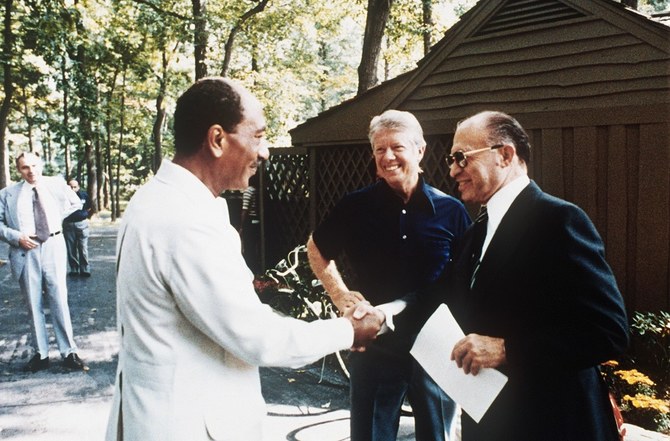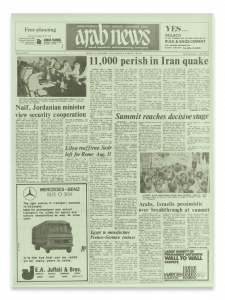- ARAB NEWS
- 03 Jul 2025

Ray Hanania
The accords between Egypt and Israel may have led to a Nobel prize, but the failure to fully realize them fueled extremism
Summary
On Sept. 17, 1978, after 10 days of intense negotiations at the Camp David US presidential retreat, Egyptian President Anwar Sadat and Israeli Prime Minister Menachem Begin signed two historic documents that ended three decades of conflict between their countries and appeared to offer the first real chance of peace in the Middle East.
As Arab News reported at the time, the talks went to the wire, with “suspense and uncertainty about the outcome” until the last moment. Thanks to the efforts of US President Jimmy Carter, however, Begin and Sadat finally agreed on the Camp David Accords — frameworks for peace in the Middle East and a treaty between Egypt and Israel.
A month later, Sadat and Begin were awarded the Nobel Peace Prize, and in March the following year they signed the Egypt-Israel Peace Treaty. Many in the Arab world, however, saw it as a betrayal of the Palestinians. Egypt was suspended from the Arab League, and in 1981 Sadat was assassinated by extremists opposed to the treaty. While a fragile peace between the two countries remains, hopes that the accords would resolve the Palestinian problem have yet to be fulfilled.
CHICAGO: When Egypt’s President Anwar Sadat went to Jerusalem hoping to prevent future wars and resolve the Arab-Israeli conflict through negotiations, he did so believing a comprehensive peace would not only include Egypt, Jordan, Syria and Lebanon, but most importantly Israel agreeing to withdraw from the occupied territories and allow for a Palestinian state.
During his lengthy speech to Israel’s Knesset (Parliament), Sadat said: “I have not come here for a separate agreement between Egypt and Israel … Even if peace between all the confrontation states and Israel were achieved, in the absence of a just solution to the Palestinian problem, never will there be that durable and just peace upon which the entire world insists today.”
US President Jimmy Carter writes to Egyptian President Anwar Sadat and Israeli Prime Minister Yitzhak Rabin to express his commitment to finding “a lasting peace settlement in the Middle East.”
In a handwritten letter, Carter appeals to Sadat for help: “The time has now come to move forward, and your early public endorsement of our approach is extremely important – perhaps vital.”
After Sadat announces his intention to visit Israel, Israel’s new prime minister Menachem Begin addresses the Egyptian people from Jerusalem, pleading for “no more wars, no more bloodshed.”

Carter writes private letters to Sadat and Begin, proposing they meet.
Sadat and Begin arrive at Camp David for 10 days of talks.
At 9:37 p.m. Carter, Begin and Sadat board presidential helicopter Marine 1 and fly from Maryland to the White House. At 10:31p.m., Begin and Sadat sign the framework for peace.

Sadat and Begin are jointly awarded the Nobel Peace Prize.
Sadat and Begin sign the Egypt-Israel Peace Treaty in Washington.
Anwar Sadat is assassinated in Cairo by Islamic extremists opposed to the peace treaty
Sadat never lived to see how right he was about how Israel’s refusal to withdraw from the occupied territories would fuel a surge in extremism, create more violence, disrupt his own nation and make regional peace impossible. Israeli Prime Minister Menachem Begin’s sole purpose was to remove the military threat posed by Egypt, divide the Arab “confrontation states” and block demands for Palestinian statehood.
Sadat never lived to see how right he was about how Israel’s refusal to withdraw from the occupied territories would fuel a surge in extremism, create more violence, disrupt his own nation and make regional peace impossible. Israeli Prime Minister Menachem Begin’s sole purpose was to remove the military threat posed by Egypt, divide the Arab “confrontation states” and block demands for Palestinian statehood.
Sadat was naive to trust Begin, one of the Middle East’s most vicious terrorists. Begin orchestrated some of the most heinous civilian atrocities during the 1947-1948 Arab-Israeli conflict, including the massacre of nearly 100 civilians in the small Palestinian village of Deir Yassin.
That massacre, with pregnant women butchered and bodies thrown into the village water well, shocked the Arab population of Palestine, prompting a refugee flight of fear. Before his Knesset speech, Sadat visited the Yad Vashem Holocaust memorial, which ironically is built on Deir Yassin’s remains.
He was being wooed by Israel and the US, and treated like a distinguished head of state, for making peace with Israel. He toured the US in 1978 and was feted at dinners in several major American cities, including Chicago, where I joined 500 other Arab Americans protesting his “surrender.”

“Mr. Carter’s experiment with solely moral coercion as an instrument of peace, while commendable, failed to produce any results because it failed to take into consideration all the variables in the complex Middle East ‘equation’.”
Arab News editorial, Sept. 18, 1978
The Camp David Accords won Sadat and Begin the 1978 Nobel Peace Prize but scorn in the Arab world. The Arab League reacted by removing Egypt as a member and moving its headquarters from Cairo to Tunis.
Israel’s strategy was clear to everyone but Sadat. He signed the accords after 12 days of intense negotiations in 1978 (Sept. 5-17). But just weeks before, Begin inaugurated the settlement of Ariel, which has become a symbol of Israel’s continuing war against Palestinian statehood and the center of settlement expansion.
Despite the disconcerting reality on the ground, Sadat went ahead and signed a formal peace treaty with Israel at the White House on March 26, 1979, officially ending the conflict between the two countries.
When you look at the five fundamentals of the accord, only two were actually achieved. Egypt did get the Sinai Peninsula back, under demilitarized conditions, and the two countries ended their state of war and established diplomatic relations.
But three conditions were never met: Meetings to resolve the Palestine question with Jordan’s involvement stalled; the introduction of Palestinian self-government in the West Bank and Gaza in five years (by 1983) failed; and an end to Israeli settlements never even began.
The accords were never allowed to stand in the way of plans to entrench Israel’s hold on the occupied territories. When US President Jimmy Carter lost re-election on Nov. 4, 1980, and Sadat was assassinated while reviewing a military parade on Oct. 6, 1981, Begin was given the green light to close the door on Sadat’s “dream.”Despite differences, US President Ronald Reagan followed up on Carter’s Middle East peace vision and proposed a “freeze” on settlements in August 1982, urging Israel to grant Palestinians “autonomy” as a step toward statehood.

Begin’s reaction was swift. On Sept. 2, 1982, with Carter and Sadat out of the way, Begin led a Knesset move to consolidate Israel’s hold on the West Bank, East Jerusalem and Golan Heights, increasing the Jewish settler population. Israel, the Cabinet declared, will “reserve the right to apply sovereignty over the territories at the end of the five-year transition period” of Palestinian “autonomy” that was specifically envisioned in the Camp David Accords.
In 1978, the settler population was only 75,000. By 1990, it tripled to 228,000. Ironically, while the accords were supposed to create an environment of hope and optimism, the failure to advance them beyond the return of the Sinai created a fatalism that fueled extremism.
Although peace between Egypt and Israel remains, the failure to achieve peace with the Palestinians has kept the accords as little more than a formal version of an armistice agreement, and relations between the two countries are defined by military cooperation.